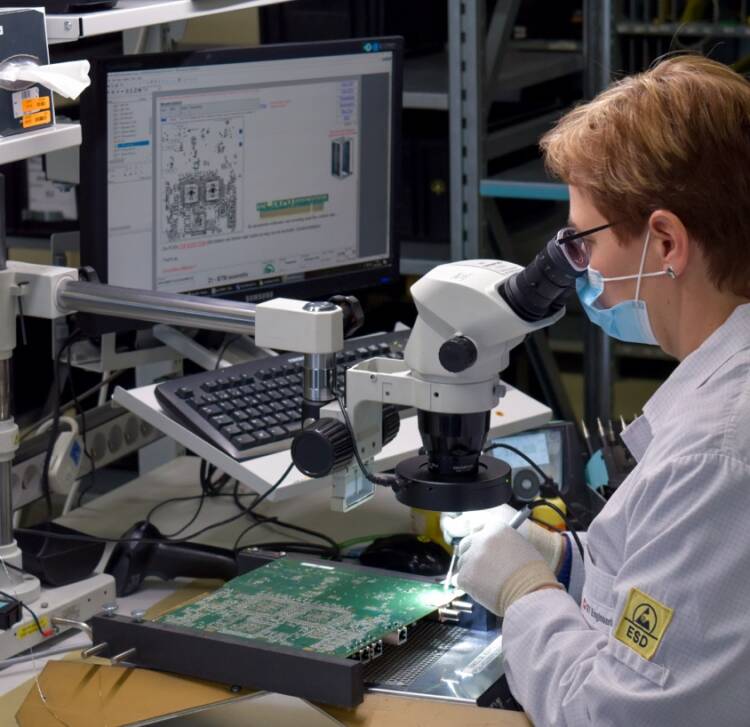
PART 4
The combined expertise of these six factories of the future leads to many interesting insights, not least for manufacturing companies that have not yet reached this stage of maturity. We therefore asked them what advice they would give to companies wishing to embark on a process of digitisation.

If you have too much waste in your processes, you will end up digitising that too.”

Maar wat leveren die data nu concreet op? De tweede horde die maakbedrijven nemen, is die data op een overzichtelijke en efficiënte manier aan de medewerkers presenteren.
Guy De Winne (ST Engineering): “De voorbije jaren verzamelden we heel wat data, maar die zat verspreid over verschillende databases, zowel vanuit de productie en machines als uit de ondersteunende diensten. We wilden ervoor zorgen dat alle informatie gecentraliseerd werd in één datacube met verschillende views. Zodat elke medewerker vlot de juiste informatie voor zijn functie uit die centrale database kan halen.”
Voor Lavetan was de verhuis naar een nieuwe, ruimere locatie het startsein voor de digitale transformatie.
Jan Robrechts: “We tekenden één geautomatiseerde waardeketen uit, vanaf het vertrek van het staal bij de klant tot en met de factuur. In onze waardeketen triggert het einde van een procesfase automatisch de daaropvolgende. De intelligentie zit dus versleuteld in het systeem in plaats van in de hoofden van de medewerkers. Die waren immers steeds moeilijker te vinden.
“Onze groei stokte door de schaarste aan labotechnische profielen op de arbeidsmarkt. Maar versleutel je die knowhow zoveel mogelijk in je systemen en processen, dan breek je die talentvijver open. Vandaag heeft ongeveer de helft van onze medewerkers geen labotechnische achtergrond meer nodig.”
Maar het bleef niet bij procesautomatisering alleen. Zo’n vijf jaar geleden startte Lavetan met robotisering, vooral om 24/7 businesscontinuïteit te garanderen. Jan Robrechts: “En sinds een tweetal jaar zitten we in de zogeheten ‘intelligente transformatiefase’. Niet harder, maar vooral nog slimmer werken is nu het motto.”
We tekenden één geautomatiseerde waardeketen uit, vanaf het vertrek van het staal bij de klant tot en met de factuur.”

5. Processen automatiseren
Part 4 – Advice for manufacturing companies

First lean, then digital

Take calculated risks
Guy De Winne (ST Engineering) is convinced that digitisation makes no sense if your processes have not been optimised. “The lean philosophy first emerged in Europe some 20 years ago. We were one of the first to get on the bandwagon. The lean mentality has always been at the forefront of all our digitisation.
First lean, then digital
This is also my advice to other manufacturing companies: make sure your production processes are as efficient as possible before you start digitising. Draw up a thorough analysis of where you could optimise. After all, if you have too much waste in your processes you will end up digitising that too. Without a good understanding of how your own production works and the logic behind the digitisation, you will never be able to eliminate that waste afterwards.”
The lean mentality has always been at the forefront of all our digitisation.”

- A well-considered roadmap is essential for making your transformation process a success.
- Have the courage to experiment. But you also need the guts to pull the plug if the project just isn’t getting the results you want.
- Step by step is the way to implement changes. With every success, you build confidence to go one step further.
- Pay sufficient attention to change management. Step away from a top-down approach and focus on involving as many employees as possible in the change.
- Identify your loss-making factors. Once you find them, you can quickly achieve results with digitisation.
- Make sure your processes are efficient and transparent before you digitise. Otherwise, you risk digitising loss-making factors too.
- Project management and coordination are crucial for large companies. This will allow you to find a consensus at all levels of the organisation.
- Compile a digitisation dictionary in which you clarify all the terminology to the stakeholders.
- Digitising for the sake of digitising is pointless. The use of technology to improve the working environment does serve a purpose, however.
- Digitisation is a continuous process. You must always be willing to adapt your digital infrastructure to current needs and opportunities.
10 tips for manufacturing companies that wish to digitise
Introducing a new technology, digitising processes that have been around for years or radically changing the way you work: no matter which step you take, there are always certain risks involved. But how do you determine which risks to take? And what if an experiment doesn’t turn out the way you wanted it to?
Take calculated risks
Duracell embodies a culture of courage. Jan Casteels: “Innovations don’t even need to be relevant or demonstrable at this point. We are always willing to go along with innovations, so any parties that inspire us in this regard are welcome. For example, the plan to create connectivity outside the factory was not something we requested ourselves, but was suggested by a partner. We are happy to take a leap of faith when it comes to innovation, knowing that there is always a risk of failure.”
“Daring to jump in at the deep end is something I recommend to other manufacturing companies. It involves a process of trial and error. Don’t try to define and engineer your entire vision in advance, just start with a single project. Identify where your losses lie. Once you go through a demonstrable and successful evolution, you end up in a positive spiral of innovation. And then the sky’s the limit!”
Vandemoortele tries to create space for experimentation in a safe environment. Pepijn Verhaeghe: “For us, digitisation does not mean that the whole company is immediately turned upside down for every innovation. We first test things in a safe and limited pilot environment. Then we make a decision: should we scale up or not? An organisation-wide roll-out may follow, but sometimes you just need the guts to pull the plug.”
Experiment safely
We are happy to take a leap of faith when it comes to innovation, knowing that there is always a risk of failure.”


PART 4
The combined expertise of these six factories of the future leads to many interesting insights, not least for manufacturing companies that have not yet reached this stage of maturity. We therefore asked them what advice they would give to companies wishing to embark on a process of digitisation.
First lean, then digital
Guy De Winne (ST Engineering) is convinced that digitisation makes no sense if your processes have not been optimised. “The lean philosophy first emerged in Europe some 20 years ago. We were one of the first to get on the bandwagon. The lean mentality has always been at the forefront of all our digitisation.
The lean mentality has always been at the forefront of all our digitisation.”

This is also my advice to other manufacturing companies: make sure your production processes are as efficient as possible before you start digitising. Draw up a thorough analysis of where you could optimise. After all, if you have too much waste in your processes you will end up digitising that too. Without a good understanding of how your own production works and the logic behind the digitisation, you will never be able to eliminate that waste afterwards.”


If you have too much waste in your processes, you will end up digitising that too.”
Take calculated risks
Introducing a new technology, digitising processes that have been around for years or radically changing the way you work: no matter which step you take, there are always certain risks involved. But how do you determine which risks to take? And what if an experiment doesn’t turn out the way you wanted it to?
Duracell embodies a culture of courage. Jan Casteels: “Innovations don’t even need to be relevant or demonstrable at this point. We are always willing to go along with innovations, so any parties that inspire us in this regard are welcome. For example, the plan to create connectivity outside the factory was not something we requested ourselves, but was suggested by a partner. We are happy to take a leap of faith when it comes to innovation, knowing that there is always a risk of failure.”
We are happy to take a leap of faith when it comes to innovation, knowing that there is always a risk of failure.”

“Daring to jump in at the deep end is something I recommend to other manufacturing companies. It involves a process of trial and error. Don’t try to define and engineer your entire vision in advance, just start with a single project. Identify where your losses lie. Once you go through a demonstrable and successful evolution, you end up in a positive spiral of innovation. And then the sky’s the limit!”
Experiment safely
Vandemoortele tries to create space for experimentation in a safe environment. Pepijn Verhaeghe: “For us, digitisation does not mean that the whole company is immediately turned upside down for every innovation. We first test things in a safe and limited pilot environment. Then we make a decision: should we scale up or not? An organisation-wide roll-out may follow, but sometimes you just need the guts to pull the plug.”
10 tips for manufacturing companies that wish to digitise
- A well-considered roadmap is essential for making your transformation process a success.
- Have the courage to experiment. But you also need the guts to pull the plug if the project just isn’t getting the results you want.
- Step by step is the way to implement changes. With every success, you build confidence to go one step further.
- Pay sufficient attention to change management. Step away from a top-down approach and focus on involving as many employees as possible in the change.
- Identify your loss-making factors. Once you find them, you can quickly achieve results with digitisation.
- Make sure your processes are efficient and transparent before you digitise. Otherwise, you risk digitising loss-making factors too.
- Project management and coordination are crucial for large companies. This will allow you to find a consensus at all levels of the organisation.
- Compile a digitisation dictionary in which you clarify all the terminology to the stakeholders.
- Digitising for the sake of digitising is pointless. The use of technology to improve the working environment does serve a purpose, however.
- Digitisation is a continuous process. You must always be willing to adapt your digital infrastructure to current needs and opportunities.